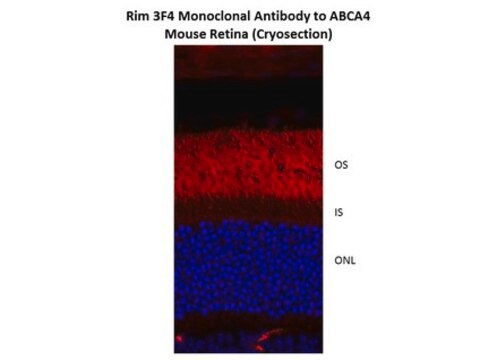MAB3077
Anti-G Protein Giα-2 Antibody, clone L5
clone L5, Chemicon®, from mouse
Sign Into View Organizational & Contract Pricing
All Photos(1)
About This Item
UNSPSC Code:
12352203
eCl@ss:
32160702
NACRES:
NA.41
Recommended Products
biological source
mouse
Quality Level
antibody form
purified immunoglobulin
antibody product type
primary antibodies
clone
L5, monoclonal
species reactivity
bovine, mouse, human, rat, guinea pig
manufacturer/tradename
Chemicon®
technique(s)
western blot: suitable
isotype
IgG2b
NCBI accession no.
UniProt accession no.
shipped in
wet ice
target post-translational modification
unmodified
Gene Information
human ... GNAI2(2771)
Specificity
Gialpha-2. Strong reactivity with bovine (100%), mouse (69%), rat (69%), human (62%) and guinea pig (43%). Specificity confirmed by Western blot versus bovine Galphat, rat Goalpha, rat Gialpha-1, Gialpha-2, rat Gialpha-3, bovine Gsalpha, and murine GoalphaA and GoalphaB.
Immunogen
Recombinant Gialpha-2, purified by the method of Linder (1990).
Application
Anti-G Protein Giα-2 Antibody, clone L5 is an antibody against G Protein Giα-2 for use in WB.
Research Category
Signaling
Signaling
Research Sub Category
GPCR, cAMP/cGMP & Calcium Signaling
GPCR, cAMP/cGMP & Calcium Signaling
Western blot 1:500 - 1:1000, with detection by 125I-labeled anti-IgG.
Labels a single protein band of 39 - 42 kDa in bovine and rat membranes.
Optimal working dilutions must be determined by end user.
Labels a single protein band of 39 - 42 kDa in bovine and rat membranes.
Optimal working dilutions must be determined by end user.
Physical form
Format: Purified
Purified immunoglobulin, in 0.02M phosphate buffer, 0.25M sodium chloride, pH 7.6, with 0.1% sodium azide.
Storage and Stability
Maintain at 2-8°C.
Other Notes
Concentration: Please refer to the Certificate of Analysis for the lot-specific concentration.
Legal Information
CHEMICON is a registered trademark of Merck KGaA, Darmstadt, Germany
Disclaimer
Unless otherwise stated in our catalog or other company documentation accompanying the product(s), our products are intended for research use only and are not to be used for any other purpose, which includes but is not limited to, unauthorized commercial uses, in vitro diagnostic uses, ex vivo or in vivo therapeutic uses or any type of consumption or application to humans or animals.
Not finding the right product?
Try our Product Selector Tool.
Storage Class Code
10 - Combustible liquids
WGK
WGK 2
Flash Point(F)
Not applicable
Flash Point(C)
Not applicable
Certificates of Analysis (COA)
Search for Certificates of Analysis (COA) by entering the products Lot/Batch Number. Lot and Batch Numbers can be found on a product’s label following the words ‘Lot’ or ‘Batch’.
Already Own This Product?
Find documentation for the products that you have recently purchased in the Document Library.
Chronic but not acute intracerebroventricular administration of amyloid beta-peptide(25-35) decreases somatostatin content, adenylate cyclase activity, somatostatin-induced inhibition of adenylate cyclase activity, and adenylate cyclase I levels in the rat hippocampus.
E Burgos-Ramos,A Hervas-Aguilar,L Puebla-Jimenez,M C Boyano-Adanez,E Arilla-Ferreiro
Journal of Neuroscience Research null
Hiromi Ohara et al.
The Journal of veterinary medical science, 75(1), 85-88 (2012-08-11)
In rodents, Gα(i2)-expressing sensory neurons (SNs) that co-express vomeronasal receptor type 1 (V1R) are specifically found in the vomeronasal organ (VNO) and project their axons to the accessory olfactory bulb (AOB). In goats, however, Gα(i2)/V1R-expressing SNs exist in both the
Kati S Mönkkönen et al.
Human reproduction (Oxford, England), 22(5), 1224-1230 (2007-03-10)
Heterotrimeric G proteins take part in membrane-mediated cell signalling and have a role in hormonal regulation. This study clarifies the expression and localization of the G protein subunit G alpha(i2) in the human endometrium and Fallopian tube and changes in
J T O'Flaherty et al.
Journal of immunology (Baltimore, Md. : 1950), 164(6), 3345-3352 (2000-03-08)
5-Oxo-eicosatetraenoic acid (5-oxoETE) stimulated human neutrophil (PMN) and eosinophil chemotaxis, PMN hexose uptake, and PMN membrane GTP/GDP exchange. Pertussis toxin (PT), a blocker of heterotrimeric G proteins (GP), completely inhibited these responses, but proved far less effective on the same
Activity of the hippocampal somatostatinergic system following daily administration of melatonin.
Rosa Maria Izquierdo-Claros, Maria Del Carmen Boyano-Adanez, Eduardo Arilla-Ferreiro
Brain Research Molecular Brain Research null
Our team of scientists has experience in all areas of research including Life Science, Material Science, Chemical Synthesis, Chromatography, Analytical and many others.
Contact Technical Service